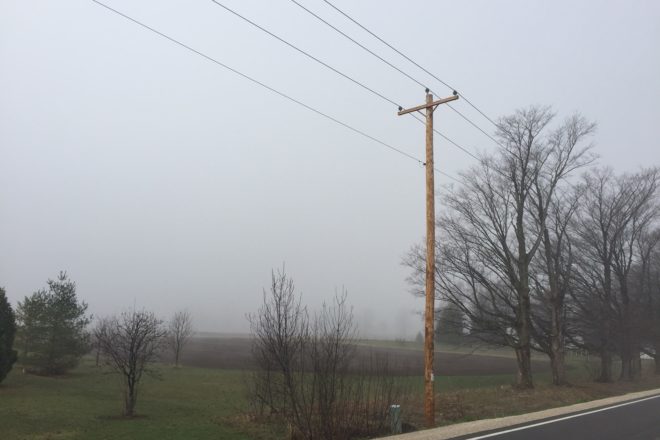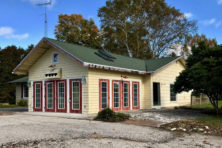Could Door County Create its Own Electric Utility?
- Share
- Tweet
- Pin
- Share


Each year Door County residents spend roughly $60 million on electricity, exporting nearly all of that to far-flung energy interests.
In the Town of Gibraltar, a glance at utility bills three years ago had Supervisor Brian Hackbarth thinking big about an idea that could keep a few of those dollars here.
When Hackbarth found out that Sturgeon Bay residents were paying 12 percent less for their electricity than Northern Door residents who are served by the investor-owned Wisconsin Public Service (WPS), he was shocked. He began researching why the city was getting such big savings, a search that turned into an investigation into what it would take to do the same thing in Gibraltar.
“It seemed like an idea that was worth looking into,” he said. “That could be a lot of money over time.”
But when the town discussed hiring a firm to study the feasibility of creating a utility company, many residents balked and the idea was quickly put to bed.
Hackbarth said he isn’t sure it’s a good idea for the town to create its own utility company, but the possible savings and other benefits it has brought to Sturgeon Bay made it worth discussing.
“I’d like to see people just start a conversation and be open to a new idea, whether it’s this one or another topic,” he said.
A Difficult Proposition
Though there are 2,006 municipally-owned utilities nationwide, and another 837 rural electric co-ops, few have been created in recent years. The last Wisconsin community to form a power company was LaFarge, which did so in 1949. Most were created between 1890 and 1920.
Forming a cooperative or a municipally-owned utility today in Gibraltar or any community would be a tremendous undertaking, said Jim Stawicki, the general manager of Sturgeon Bay Utilities, which is owned by the city.
“To buy infrastructure from the existing utility is difficult,” he said. “You would have to buy that infrastructure and you’re not necessarily guaranteed lower rates. You would be looking at 10 to 20 years to earn the payback. Then there are the costs to acquire the expertise in engineering and management.”

“Instead of having decisions made in a distant corporate boardroom, they’re made at city hall in open meetings.” ~ David Benforado, Executive Director, Municipal Electrical Utilities of Wisconsin
David Benforado, the executive director of the Municipal Electric Utilities of Wisconsin, seconded Stawicki’s comments.
“I try to be supportive of communities considering creating their own utility, but it would be difficult – that’s just a fact of the matter,” he said. “It won’t be an easy lift, but it’s possible.”
Stawicki said there are four key components required to create a municipal utility: you need to buy the infrastructure; develop the planning; gain the expertise; and, most importantly, you need to have the community willing to go through the process.
“Your community has to have the fortitude and belief that it’s the right thing to do,” Stawicki said. “It’s an uphill battle to get there. The community would have to be very united.”
In the late 1990s Hermiston, Ore. – a city of 16,745 people in the sparsely populated high desert region of the state about three hours east of Portland – grew frustrated by the service it was getting from Pacific Power and Light (PP&L). About two thirds of the city was served by PP&L, while the other third was served by the Umatilla Electric Cooperative (UEC).
When PP&L shut down its service center in the city residents soon saw service levels decline.
“Rates were going all over the place,” recalled Bob Irby, who has lived in the city for 44 years. “When they closed the service office it kind of disturbed folks here, so they approached the co-op to see if they wanted to buy out Pacific. But Pacific didn’t want to sell.”
A movement to create the city’s own utility soon gathered steam, but it took four years and a narrowly passed city referendum to launch the utility.
Russ Dorran, a retired employee of UEC, was hired to manage the new Hermiston Energy Services, which contracts with UEC to perform maintenance and handle meter reading for the utility. The city paid $8 million to purchase PP&L’s infrastructure, a hefty price tag considering that the city placed the book value at $2 million. Dorran said the city took out a $13.2 million loan to buy the power infrastructure from PP&L and cover additional expenses in the legal fight and campaign to pass the referendum.
That’s a huge project to swallow, but today the city has $6 million in equity in its utility and has added significant line extensions, underground infrastructure and other improvements to its infrastructure, though it has only paid the loan down to $12.5 million.
More significantly for residents, the city’s electric rates are 49 percent lower than those paid by PP&L customers, and the rates haven’t changed in 10 years, according to Dorran.
Sturgeon Bay’s Best Investment
In 1904 the City of Sturgeon Bay decided it couldn’t wait to become a priority for electric companies and established its own utility. With the formation of Sturgeon Bay Utilities (SBU), the city joined a flood of rural communities that formed their own municipal utility companies when electric companies were uninterested in serving isolated areas.
“Corporations told rural communities: we’ll get to you, in time,” said Benforado. “Many of those communities didn’t want to bank the economic future of their communities on the promises of a corporation.”
That decision has paid enormous dividends for the city over a century of service.
The city’s 7,600 residential customers use an average of 640 kilowatt hours of electricity per month, Stawicki said. At rates 12 percent lower than they would pay through Wisconsin Public Service that resulted in savings of $700,000 in 2011. An additional 1,500 urban and rural commercial customers (such as restaurants and retailers) saved a combined $472,000 last year.

These solar flairs out front of the SBU office in Sturgeon Bay help power the city. Photo by Len Villano.
That’s a total savings of $1.17 million dollars in one year for customers in the city and surrounding communities served by SBU.
There are several factors that result in municipally owned utilities being able to charge lower rates, but it’s not by producing their own power.
There are 82 publicly-owned utility companies in Wisconsin. Sturgeon Bay Utilities belongs to WPPI, an association made up of 51 publicly-owned utility companies, including seven in Michigan and three in Iowa. Those utilities purchase their power from a variety of sources, including coal, wind, solar, and nuclear power, through WPPI.
The biggest factor creating lower rates is simple. Municipally owned utilities are in the business for purpose, not profit. They don’t have the investors to pay dividends to that private power companies do.
But lower rates aren’t the only impact the local utility has on the community. Sturgeon Bay Utilities employs 20 people who live in the city and surrounding area who earn about $1.9 million in wages and benefits each year.
In addition, Stawicki said he tries to purchase locally as much as possible. That includes electrician services, vehicles, and repairs.
Then there’s the windfall for the city that comes in the form of SBU’s annual Payment In Lieu of Taxes. In 2011 that payment was $324,000 from the electric utility (the Water and Wastewater portions of SBU made an additional $316,000 payment). WPS pays taxes, but those go to the state, with only a portion of that trickling back to municipalities. The SBU payment goes directly to city coffers.
Add it up and you get a minimum of $3.39 million that stays in the Sturgeon Bay community, most of which would be funneled off the peninsula if the utility didn’t exist.
The Co-op Route
Sturgeon Bay isn’t the only Door County community that has its own utility. Washington Island residents are served by the Washington Island Electric Co-op, established in 1939 with money borrowed from the Rural Utility Service (RUS).
The RUS was created when Congress passed the Rural Electrification Act in 1936 to bring electricity to communities that were still being ignored by power companies. The service provided federal loans for the installation of electrical systems in rural areas, funneled through electric cooperatives.
Unfortunately for the Washington Island residents who formed the electric co-op, their timing could not have been worse. When the United States entered World War II all spending on the RUS stopped, and Washington Island didn’t get energized lines until after the war in 1946. Today, the co-op continues to provide electricity to the island as a private not-for-profit.
“It simply wouldn’t have been profitable for an investor-owned utility to come up here and provide power,” said Robert Cornell, the co-op manager.
The island doesn’t reap the huge savings that SBU does. In fact, island utility rates are slightly higher than those paid by Northern Door residents, due to the small size of the community and the unique infrastructure needed to bring power to the island.
The island electric cooperative purchases power wholesale from WPS, which is brought across Death’s Door via a 4.5-mile long cable laid at the bottom of the lake in 1981. Cornell estimates that 5 – 6 percent of the power the island purchases is lost transmitting the power from the Sister Bay substation, over the underwater cable, and through the transformer on the island.
“Bringing power to the island becomes pretty capital intensive,” Cornell said. “We have those additional fixed costs, then we have a much lower population density. We have the highest cost per member and highest cost per mile of utility lines of any electric co-operative in the country.”
An Idea Worth Considering
As Hackbarth found out, the road to creating a public utility isn’t smooth, but it’s not impossible to navigate. Just down the road in Sturgeon Bay there is plenty of evidence that the idea is worth considering, and the reasons go far deeper than saving money on each month’s utility bill.
“Instead of having decisions made in a distant corporate boardroom, they’re made at city hall in open meetings,” Benforado said. “It’s community owned and locally controlled. The community has the opportunity to dovetail energy decisions with the goals of the larger community.”
It’s a big idea, and those are never easy.




